1.3 Medication Forms and Routes
Medication Routes and Forms
Medications can be given using many routes, and different forms of medication can be given through those routes. Also, some medications can be given in various routes; for example, Gravol can be given orally, intravenously, and intramuscularly. However, this does not apply to all medications. The route and form in which a medication is given will vary depending on the medication itself, the reason for administering the medication, and the patient. The most common drug routes and drug forms are described below; parenteral routes will be described in the next section.
Oral Medication Route
The oral route (abbreviation po) is one of the most common for medication administration, and many forms of medication can be given this way. The main advantage of the oral route is ease of administration. Medication taken via the oral route has slower onset, and typically the effect lasts longer but is less potent than other routes. There are some disadvantages to the oral route because some medications cannot be given orally, and some patients cannot take oral medications due to nausea and vomiting or if they are unconscious. In addition, some oral medications interact with certain foods and beverages, which can cause the medication to become inactive or produce severe side effects. In these cases, the medication would be given through another route.
Oral Drug Forms
Tablets
A tablet (abbreviation tab) consists of an active ingredient, which is the medication, and an inactive ingredient, which consists of fillers and binders so that the medication has a certain shape, size, and colour. Sometimes this is important to those that are on oral medications because it helps them identify their pills once they are taken out of the original packaging. There are several tablet drug forms described in the highlighted box below.
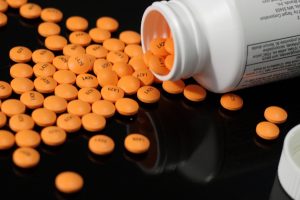
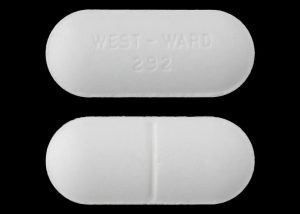
Tablet Forms
- Scored: This type of tablet is marked so it can be divided into equal portions depending on the dose prescribed (Fig. 1.3). If only half a dose is needed, the patient can easily break the tablet into two separate doses.
- Enteric coated: This type of tablet has a hard outer coating that helps make it easier to swallow and protects the stomach from irritation (Fig. 1.4). The coating dissolves slowly so the medication is absorbed in the small intestine rather than the stomach.
- Effervescent: This type of tablet must be dissolved in water before being administered to a patient and “fizzes” as it dissolves; click on the video above to view this process. Antacid medications are an example of an effervescent tablet.
- Slow release: This type of tablet is produced so that the effects last over a longer period of time. Abbreviations associated with the trade names of these tablets include CD (controlled delivery), ER (extended release), LA (long lasting), SR (slow release), and XL (extended length).
- Caplet: This type of tablet is usually oblong in shape and tends to be easier to swallow than other tablet types (Fig. 1.5).
- Lozenge: This is a hardened, usually sweetened tablet form and is almost candy-like (Fig. 1.6). It should not be swallowed, but rather placed in the mouth and allowed to slowly dissolve. Lozenges are typically used to treat a sore throat.
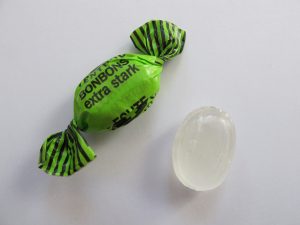
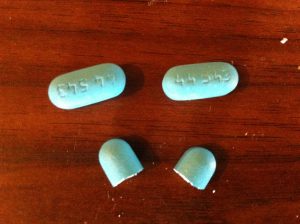
Capsules
A capsule (abbreviation caps) is either one piece—a liquid medication enclosed in a soft outer layer—or two hard pieces that fit together and are filled with either a powder or small granules. The hard capsules come in various colours, which helps patients identify their medications. Most capsules are intended to be swallowed whole, but there are exceptions. In any case, it is important to speak to a pharmacist to ensure that the medication is taken properly. Fig. 1.7 shows two soft, one-piece, liquid-filled capsules and two hard, two-piece, powder- or granule-filled capsules .
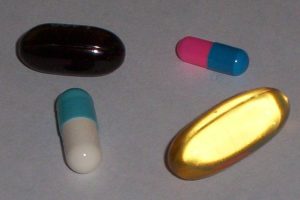
Liquids
Many medications come in liquid form and can be given orally, but can also be given through other routes, including a nasogastric or gastrostomy tube. These routes will be discussed in more detail later in the chapter. The textbox below lists and describes the most common oral liquid drug forms.
Liquid Drug Forms
- Elixir: This type of liquid medication is mixed with water and alcohol, as well as additional flavouring and colouring to enhance taste and appearance. It is commonly used for children and elderly patients who have difficulty swallowing.
- Syrup: This type of medication is mixed with thickened water, colour, and flavouring. Because this liquid is thicker and coats the throat as it is swallowed, it has a soothing effect and is often used for medications that treat sore throats and coughs.
- Suspension: This type of liquid medication contains fine particles of the drug suspended in either water or an oil base (Fig. 1.8). It is very important to shake this medication well before taking it because the medication usually settles to the bottom, and the water or oil remains on the top.
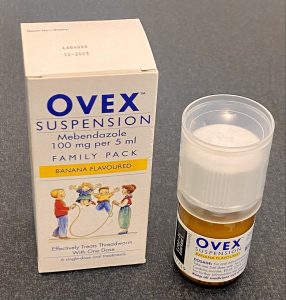
Sublingual and Buccal Routes
The sublingual route (abbreviation sl) is similar to oral medication administration but differs in one key aspect—in sublingual medication administration, the medication is held under the tongue and dissolves. This is ideal in that the medication does not need to be swallowed and begins working more quickly because it is absorbed through the mucous membranes under the tongue.
The buccal route is similar to the sublingual route in the sense that the medication is not swallowed, but rather the medication, usually a tablet, is placed in the pouch between the cheek and the lower lining of the gums.
The textbox below describes some of the most common drug forms that can be given via the sublingual and buccal routes.
Sublingual and Buccal Drug Forms
- Film: This is a small dissolving strip that contains a medication and can either be placed under the tongue or in the buccal pouch, where the strip dissolves and the medication is absorbed quickly into the bloodstream (Fig. 1.9).
- Liquid spray: Sprays are usually administered sublingually, but depending on the medication, can also be sprayed into the mouth and absorbed via the mucous membranes. Fig. 1.10 (right) shows a common example, nitroglycerine, in a red spray bottle.
- Tablet: Sublingual and buccal tablets should not be swallowed and are most effective when placed under the tongue or placed between the cheek and gum and allowed to dissolve.
- Powder: This type of powder is emptied from the packet and placed sublingually so it can dissolve and be absorbed into the bloodstream (Fig. 1.9).
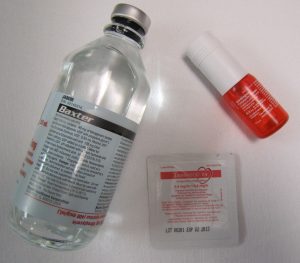
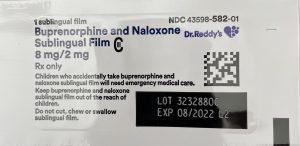
Nasogastric and Gastrostomy Tube Routes
The nasogastric (N/G) and gastrostomy routes are generally used when a patient cannot take their medication orally. The medication is delivered either through a nasogastric tube (N/G tube) or a gastrostomy tube (G-tube) that goes directly into the stomach or small intestines. Most medication that can be given orally can be given in this manner. Once approved by the pharmacist, medication can be crushed and administered via the tube or can come from the pharmacy already prepared. Fig. 1.11 is an image of an NG tube, and Fig. 1.12 shows medication being instilled into a gastrostomy tube. The preferred drug form for this route is liquid because it decreases the risk of blockage within the N/G or G-tube, and the absorption rate is better when the liquid drug form is used.
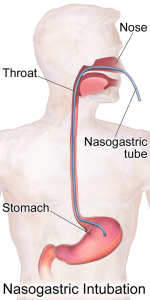
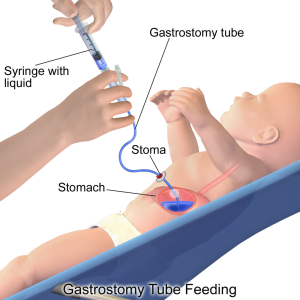
Inhalation Route
The most common way to administer medication via the inhalation route is by inhaler. There are a number of different types of inhalers, and they vary depending on the medication and the reason for administration. The most common drug forms given via the inhalation route are powders, liquids, and gas in some type of container (inhaler) that allows the medication to be inhaled and absorbed into the lungs. A nebulizer is another way that inhaled medications are delivered. A nebulizer is a small machine that changes liquid medication into a mist that the patient breathes in, usually through a mask worn over the nose and mouth. The textbox below lists the different devices that are used for the inhalation route.
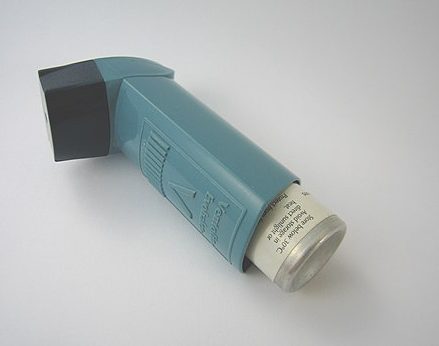
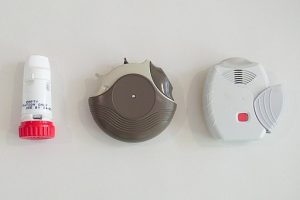
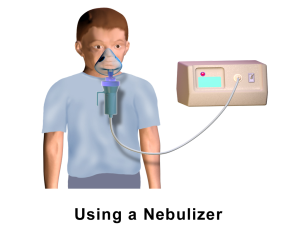
Inhalation Drug Devices
The following devices can be used to deliver various inhalation drug forms:
- Metered-dose inhaler (MDI) (Fig. 1.13)
- Dry powder inhaler (Fig. 1.14)
- Nebulizer (Fig. 1.15)
These devices will be discussed further in Chapter 5, section 5.4 Respiratory Medications.
Rectal Route
The rectal route (abbreviation pr) is used when a patient has issues taking medication orally. It is also commonly used with children because many young patients are unable to take medication orally or have difficulty swallowing medication. Some pain medication can be given through the rectal route in the form of suppositories, but others can be given in the form of creams, lotions, or ointments. If a patient is constipated or needs contrast for a scan, they might be given an enema. The textbox below describes the different drug forms that can be administered rectally.
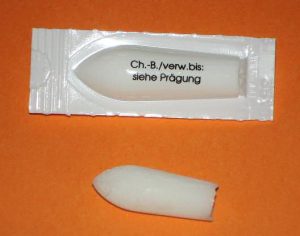
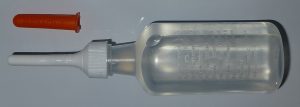
Rectal Drug Forms
- Suppositories: A rectal suppository is shown in Fig. 1.16. Several medications can be given in this form, including analgesics, anti-inflammatories, and laxatives.
- Creams, lotions, and ointments: These medication forms are used to treat conditions such as rectal pain, itching, and inflammation and hemorrhoids.
- Enema: An enema is shown in Fig 1.17. Medications are given as an enema to treat conditions such as constipation and sometimes as a preparation for a test (e.g., barium enema).
Vaginal Route
Medication delivered using the vaginal route (abbreviation pv) is absorbed quickly, and this route might be used to treat specific conditions such as vaginal fungal and yeast infections and vaginal dryness, or for contraception or hormone replacement (Lillis, 2018). The drug forms used for the vaginal route are suppositories, vaginal tablets, creams, foams, and ointments. Fig. 1.18 shows vaginal foam and vaginal tablets (suppositories) used for contraception.
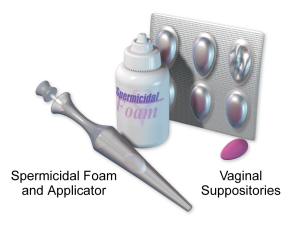
Topical Route
Topical medications can be applied to the skin, eyes, and ears. They typically work locally, which means they only have a therapeutic affect on the area where they are applied. Absorption is usually slower through the skin but generally produces a steady, longer-lasting effect. Various drug forms that can be used topically are briefly described in the textbox below.
Topical Drug Forms
- Drops: Various drop solutions can be given either into the eye, ear, or nose, depending on the reason for administration. Some common medication types are antibiotics, numbing agents, and lubricating drops. The abbreviation for drops is gtt.
- Lotion, creams, and ointments: These are all similar, the main difference being the amount of oil or water that is used in combination with the active ingredients of the medication. The abbreviation for ointment is ungt.
- Powder: Powders are applied to an affected area and are used to treat various pathologies such as fungal infections, which can be treated with nystatin powder (Cleveland Clinic, 2022).
Transdermal Route
The transdermal route is very similar to the topical route, but there are differences. Transdermal patches are applied to the skin and left on so the medication can be absorbed slowly. A common example is the nicotine patch (Fig. 1.19), which is used to help people quit smoking. Medications are also given via this route for pain, depression, pregnancy prevention, nausea, heart issues such as angina, and hormone replacement (Fig. 1.20). Another difference between transdermal patches and the topical route is that transdermal medications typically act systemically, which means the medications have a therapeutic effect throughout the body rather than just locally.
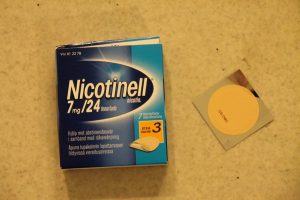
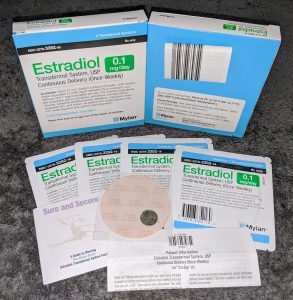
Review
Attribution
Unless otherwise indicated, material on this page has been adapted from the following resource:
Ernstmeyer, K., & Christman, E. (Eds.). (2020). Nursing pharmacology. Chippewa Valley Technical College. https://wtcs.pressbooks.pub/pharmacology/, licensed under CC BY 4.0
References
Cleveland Clinic. (2022). Nystatin topical powder. https://my.clevelandclinic.org/health/drugs/18930-nystatin-topical-powder
Lillis, C. (2018, August 29). How do you use vaginal suppositories? Medical News Today. https://www.medicalnewstoday.com/articles/322908#what-are-vaginal-suppositories-used-for
Image Credits (images are listed in order of appearance)
Methocarbamol 750 MG Oral Tablet by National Library of Medicine (NLM), Public domain
Regular strength enteric coated aspirin tablets by Ragesoss, CC BY-SA 4.0
Effervescent tablet (video) by Hangsna, CC BY-SA 3.0
Three Blue Cold and Allergy Caplets by ParentingPatch, CC BY-SA 3.0
Hustenbonbons 02 by Kritzolina, CC BY-SA 4.0
Gelcaps by Keffy, CC BY-SA 2.5
Mebendazole_liquid by Whispyhistory, CC BY-SA 4.0
8-2 Suboxone by Sintegral, CC BY-SA 4.0
Nitro by James Heilman, CC BY-SA 3.0
Nasogastric Intubation by BruceBlaus, CC BY-SA 4.0
Gastric Feeding Tube Infant by BruceBlaus, CC BY-SA 4.0
Inhaler1 by ben dalton, CC BY 2.0
Dry powder inhalers by BrettMontgomery, CC BY-SA 4.0
Nebulizer Mask (Child) by BruceBlaus, CC BY-SA 4.0
Suppositorien by Nynyny, CC BY-SA 3.0
Enema prepared, disposable by Helen4780, CC BY-SA 4.0
Spermicidal Foam & Suppositories by BruceBlaus, CC BY-SA 4.0
NicotinePatch by Styroks, CC BY-SA 4.0
Generic estradiol (Mylan) 0.1 mg per day once-weekly transdermal systems by Medgirl131, CC BY-SA 4.0

